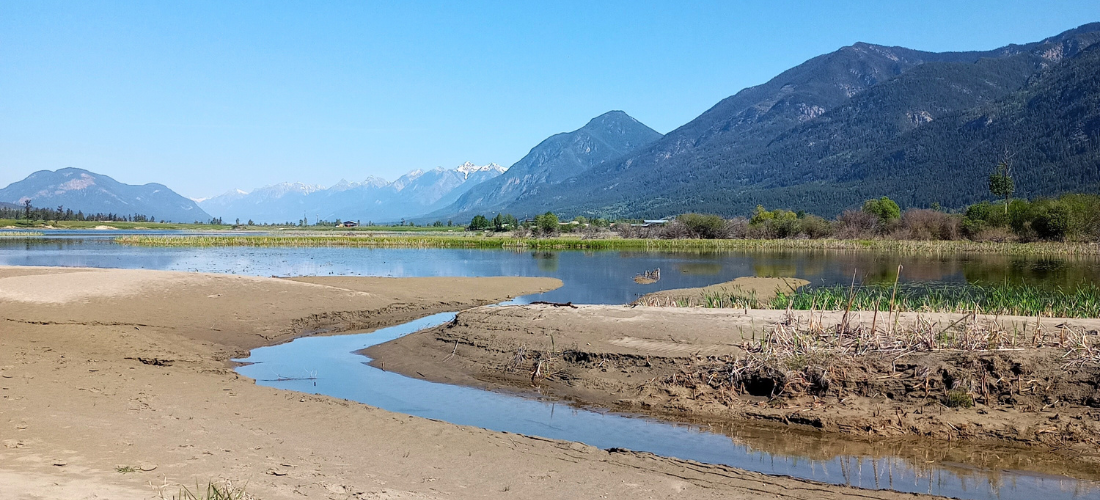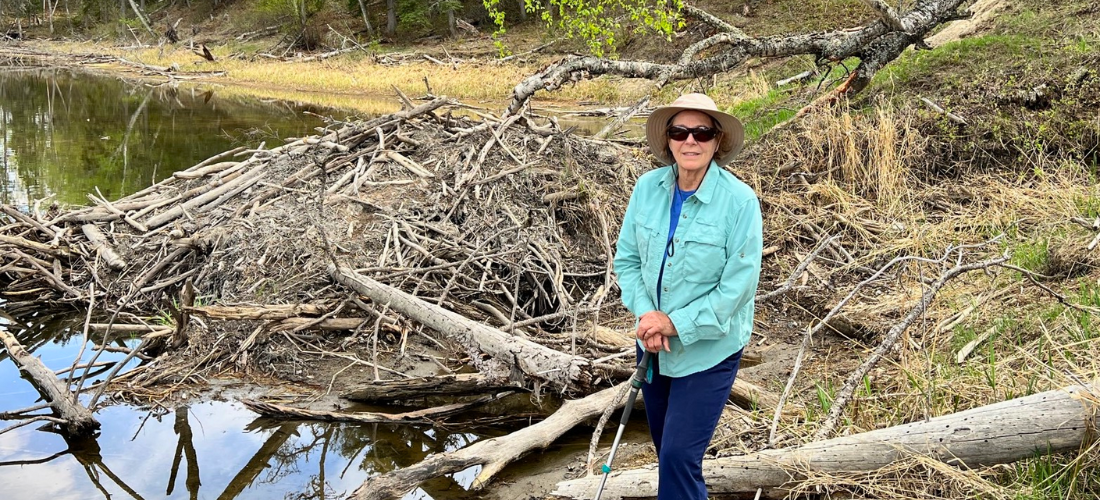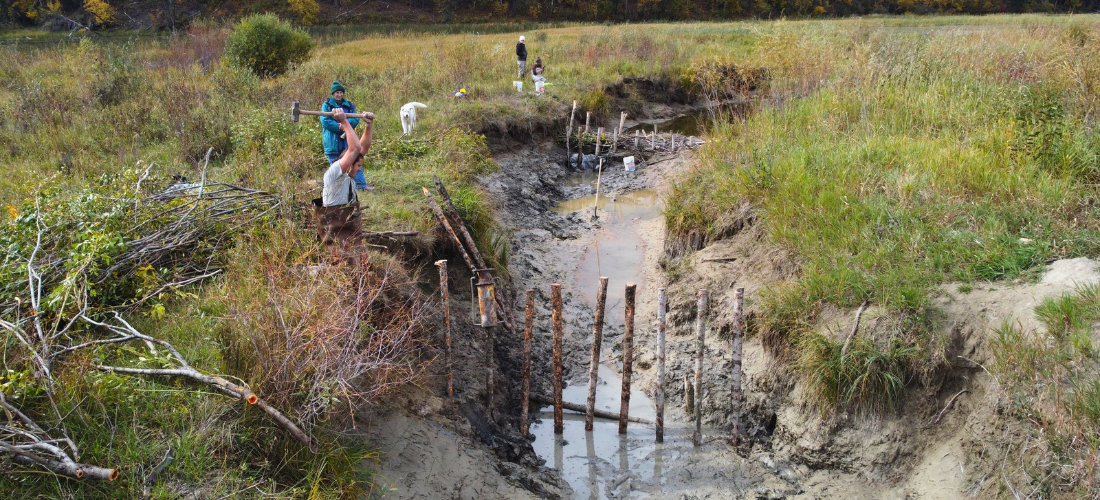“Playing Beaver” to Restore Water to the Columbia Wetlands
The water stewardship work in this story is located on the unceded shared territory of the Ktunaxa and Secwepemc people, home to the local communities of Akisqnuk First Nation, Shuswap Band and the chosen home of the Columbia Valley Metis.
“We want to know which wetlands are the most vulnerable and the most valuable. This is a hard question to answer because they are all vulnerable and valuable… and they all need water,” said Suzanne Bayley, President of the Columbia Wetlands Stewardship Partners.
The Columbia Wetlands are drying — and they have been for many decades due to climate change. One solution may help wetlands adapt and safeguard their key ingredient. It involves mimicking the actions of one of the most iconic and ubiquitous animals across Canada.

Stretching over 180-kilometres and across 26,000 hectares, the Columbia Wetlands in southeastern B.C. are teeming with biodiversity and provide a cornucopia of benefits to surrounding communities. Flood control, groundwater recharge, irrigation needs, water purification, and carbon storage — these wetlands aid it all. As part of the Pacific Flyway, one of North America’s four major migratory routes, the waters of the Columbia Wetlands provide a safe haven for over 160 species of migratory birds including at-risk Tundra Swans.
Wetlands are among the most productive ecosystems globally, yet one of the most threatened. Since 1970, one third of all wetlands have been lost. Although the Columbia Wetlands are RAMSAR-designated and internationally recognized, approximately 40% of this pristine floodplain remains unprotected. It’s critical that steps are taken to better understand and protect this wetland system. When wetlands are protected, everybody wins.
On the ground in the Columbia Wetlands, research has found that water-loving plants are being replaced by willow, a plant that requires less water. Over the last 39 years, the spread of willow has doubled in the wetlands, pointing to a drying landscape. Wetlands that once held open water all year long are now often dry in the winter and spring. Now, migrating birds are left with fewer options to rest and feed during long journeys. In fact, certain tracts of the Columbia Wetlands have lost over 16% of its permanent open water area in the last few decades.

The disappearing act of water from the Columbia Wetlands is troublesome, but not a surprise. Behind the curtain, climate change is resulting in increasing temperatures, decreasing snowmelt and receding glaciers. This means there is less water to fill and flood these critical wetlands. But, the behaviour of one sharp-toothed, web-footed and paddle-tailed animal shines a light on a way to help maintain water in the wetlands.
Beavers are known as ecosystem engineers, weaving trees and branches into mud-fortified dams and lodges. Beaver dams function as natural levees and create partially connected wetlands. During floods, water pours over the dam and gets trapped behind its walls. The landscape then is able to hold the water, rather than letting it drain away and travel downstream by river or stream. Like a plug in a bathtub, beaver dams help increase open water areas for wildlife.
“Anything we do in the long term is in the face of declining water due to climate change. But, what we can do is continue efforts to help keep open water in the Columbia Wetlands through restoring abandoned beaver dams,” said Bayley, who is championing scientific research and restoration in the area.
According to Bayley, it isn’t known why beavers are absent from the upland wetlands. Possible reasons include a lack of adequate water to keep the wetlands healthy, lack of suitable food, increase in predators and historic trapping.
“Beavers could be reintroduced, but this would require a permit, and unless we know why their populations are failing, they’re likely to fail again,” said Bayley.

Wetland research and stewardship is spearheaded by the Columbia Wetlands Stewardship Partners (CWSP). As a member, Living Lakes Canada has worked alongside CWSP and its partner organizations since 2006 to develop and promote effective stewardship of the Columbia Wetlands.
This past summer, Living Lakes Canada staff supported CWSP in assessing the upland wetlands on the western bench of the Columbia Wetlands. The findings show scientific evidence of a 50-year drying spell; the same is observed throughout the valley bottom wetlands. Water escapes these upland wetlands through old, deteriorated beaver dams.
“Through drone surveys, we’ve seen that previously intact wetlands are transitioning into shrubs and conifers. Wetlands are no longer functioning as wetlands because they’ve been dry for a very long time,” said Jessica Holden, Wetlands Technician with Living Lakes Canada.
One possible solution to the problem is “playing beaver.”

Armed with large posts, clay, mud and plenty of debris, the wetlands team aims to repair beaver dams at nine identified restoration sites. Known as beaver dam analogues, the human-made beaver dams will help retain water in the upland wetlands.
Key to measuring the success of this restoration project is monitoring before and after the beaver dam restoration. Bird surveys, wetland vegetation observations, benthic macroinvertebrate sampling, and more will provide insight into how the wetlands are responding.
“We want to see more cattails, bullrushes, water lilies and open areas of water – all signs of a healthy wetland,” said Catriona Leven, Wetland Ecologist with CWSP.

The Columbia Wetlands are one piece of a larger watershed puzzle. A broader understanding of climate impacts on water across the region will provide additional insights. Living Lakes Canada’s Columbia Basin Water Monitoring Framework is building a large-scale hydroclimatic monitoring network across five areas throughout the Canadian Columbia Basin, including in the Columbia-Kootenay Headwaters hydrologic region where the Columbia Wetlands are located. Comprehensive monitoring of these watersheds over the long term will provide the necessary data to support local and regional climate adaptation efforts.
Story updated on Nov 14, 2023.
The Columbia Wetlands need your support to adapt to climate change. Your donation will help protect the Columbia Wetlands and support wildlife and communities dependent on this threatened ecosystem.





